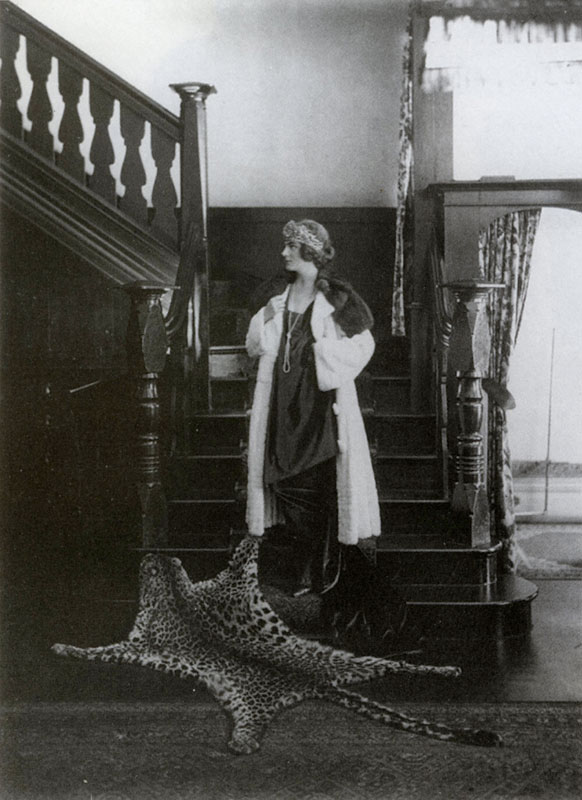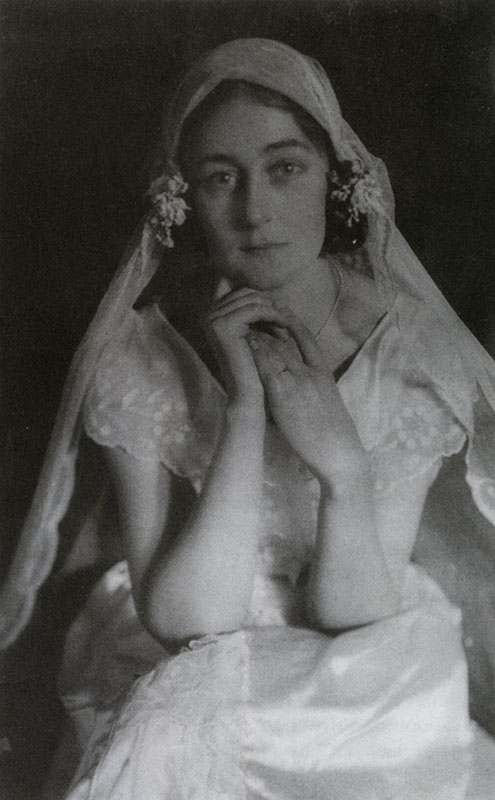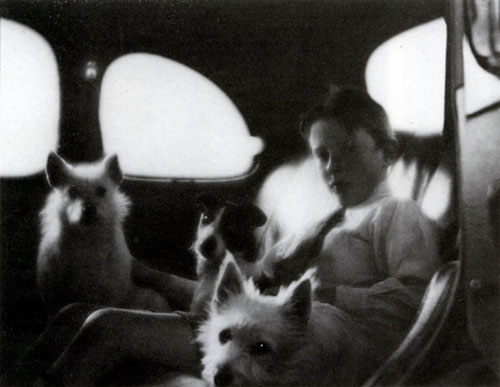RUTH HOLLICK
and portrait photography between the wars
Gael Newton and Karen Jacubec
Originally published Australian Antique Collector 54thEdition, December 1997– June 1998
All parents delight in portraits of their children and today, family, child and school photography is big business. From the debut of photography in the 1840s parents rushed to have their children photographed but the long exposures then necessary made the process a trial for all concerned.
Early photographers even resorted to doses of laudanum to quiet babies and toddlers for their portrait sessions. By the turn of the century, however, photographing children was much easier as exposure speeds were faster and thanks to Kodak cameras and processing, photography was a familiar part of family life. Amateur and professional child and family portrait photography flourished and specialist studios could cater to a new niche in the market.
| |
 |
|
| |
Ruth Hollick, Miss Pearce, Fashion illustration for 'The Home \ March 1921,
Gelatin silver photograph, printed 1997 from an original negative. |
|
| |
|
|
| |
 |
|
| |
Ruth Hollick, Mrs. A.E.M. Kirkwood c.1925,
Gelatin silver photograph. Collection: National Gallery of Australia |
|
By 1900 women had joined the work force in greater numbers and had more career opportunities than nursing, teaching or office work. One of the phenomena of this period of Australian photographic history before World War I is the emergence of the first generation of women professional photographers. For a number of the more adventurous spirits of the day, photography offered independence and safe self-employment.
These women also found that their social skills, attention to detail and creativity well suited the field of portraiture and so by 1920 the first generation of women photographers had emerged. Among their ranks was the Melbourne photographer, Ruth Hollick, who became well known as a specialist child photographer.
Ruth Hollick's enthusiasm for her child subjects and her professional skills are evident in the Hollick Collection held by the National Gallery of Australia, Canberra. In 1979 the Gallery purchased a number of Hollick's prints taken in the 1920s and 1930s. Over 1000 negatives were included in the Hollick acquisition which, combined with the prints, covered all aspects of her work between 1910 and the 1930s. They included child studies and studio society portraits, scenes and portraits taken at rural and pastoral homes, as well as personal material related to the artist and her travels.
It has taken years of cataloguing and contact printing of the National Gallery's archive to understand Hollick's place as a significant Australian photographer. The Gallery was fortunate to have assistance on the project from several dedicated volunteer researchers. Vanessa Griffith, a National Gallery guide, spent considerable time tracking many of the families, and two interns, Annabel Dent and Nina Sellars, respectively catalogued and printed the negatives. Annabel Dent also documented and analysed Hollick's importance as a pioneer of fashion photography in Australia.
Ruth Hollick was born in 1883 and grew up in a middle-class family in Moonee Ponds, Victoria. She had ambitions to follow a career as an artist and studied from 1902 to 1906 at the National Gallery School in Melbourne where she made a number of life-long friends. It is not known why Hollick switched to photography as a career, as this was not a subject at the Art School, nor how she learnt professional processing and studio camera operation. She was perhaps inspired by both the Pictorial "art photography movement of the turn of the century and the Arts and Crafts revival which promoted applied art and design work.
Hollick began working professionally in 1908. Having learnt the process of stand camera glass-plate photography and contact printing, she launched her career by avoiding the cost of a studio and instead travelled in rural areas of Victoria in search of photographic work. She bought herself a small car, then an expensive item and not usual for a single woman to purchase or drive. In this car she travelled the Western Districts and Riverina areas.
She would advertise in advance of her arrival in the towns en route that 'Ruth Hollick would be available to take portraits' on a particular day. This was a demanding apprenticeship as many shots were done in available light or in the open air. She printed and despatched work from the studio in the family home at Moonee Ponds.
Few of Hollick's works from these early itinerant years can be positively identified although the glass negatives in the Hollick archive date back to the years between about 1908 and 1915. Many of these are charmingly informal scenes of children going off to school.
Hollick succeeded as an itinerant photographer and later in 1918 formed a partnership with Dorothy Izard, a friend whom she had met at Art school. The pair took over Mina Moore's well-known portrait studio in the Auditorium Building in Collins Street, Melbourne, which had opened in 1913. Throughout the next decade the Ruth Hollick studio flourished as a portrait studio which specialised in child photography. Her logo was a kookaburra on a camera — perhaps a witty twist on the 'watch-the-birdie' cry of the portrait photographer. Business was brisk and the studio was fashionable, being the location for a number of parties and gatherings with Hollick's artist circle of friends. When Chatteris House was built next door in the 1920s, Hollick extended her studio into one whole floor of the new building.
| |
 |
|
| |
Ruth Hollick, iQuentin Cain (son of Mrs W. N. Cainf c.1930
Gelatin silver photograph. Collection: National Gallery of Australia |
|
Hollick and Izard worked in the city until 1929 when they relocated to Hollick's family home in Moonee Ponds. Here Hollick kept up her photographic work until the 1950s. She died in 1977, just as the women's movement and a boom in photography was inspiring research into the pioneers of photography. Hollick's work was included in the first study of women photographers, Australian Women Photographers 1840-1960, published in 1986 by researchers Barbara Hall and Jenni Mather.
The National Gallery print collection and negative archive contains a number of especially notable portraits. For example, a series of studies of Dame Nellie Melba and her granddaughter Pamela Armstrong, taken at Melba's residence, Coombe Cottage, in 1918, show an uncharacteristically sensitive study of the great and often imperious Melba holding the baby in a composition reminiscent of a Madonna and child. The minimal lighting with the two faces just touching, as if the baby has just been kissed, makes the viewer a privileged witness to a private moment.
Fashion photography was part of a new stream of commercial work for magazines in the 1920s and Hollick often excelled in combining commercial needs with sensitivity and novelty. The quiet scene of a girl in a white frilly dress gazing at a posy was a fashion illustration in the Home of December 1920. The frock is shown to its full advantage in the profile pose of the young girl and there is nothing on the bare wall and floor to detract attention. In the pristine simplicity of this work there is an echo of the turn-of-the-century fashion for portraits of dreamy gids and young women in virginal white dresses. Other of her portraits seem to be inspired by Victorian painting styles in general and one imitated the famous little boy in velvet in the painting, Bubbles, executed for a soap advertisement by John Everett Millais.
Another study published in the Home of a young girl and her bears shows the remarkable ease with which Hollick approached child photography and illustration. Here, the small child in Sunday best is shown in an adult-sized world with her all-important furry companions. This may bring back viewers' memories of their own childhood. If not for the soft toys and large area of the floor, the child would be lost in space and light. The gaze to camera of the child becomes the focus of the viewers as they contemplate the unseen photographer and camera that the child was sitting for. In this charming study can be seen Hollick's skill and ability to capture the informality of children even when the situation was posed for the camera.
One of the National Gallery's best known prints from the Hollick collection is the 1936 portrait of young master Quentin Cain taken inside the family car in which the family pets all obediently look toward the camera from the back seat. This portrait, like Miss Beggs, is both candid and studied at the same time. Hollick's confident yet novel approach has captured the atmosphere of the leisurely lifestyles of country society during the 1930s. This is one of the most inspired and technically difficult examples of child photography in Australia.
Even in the studio Hollick constantly experimented with new settings and ideas as in the portrait of brothers John, David and Brian Wilbur-Ham. The small boys are identically dressed in their winter clothes and the seasonal theme is carried through by making them huddle under a big umbrella. Hollick has again shown that these are little people in an adult-sized world. A more elaborate setting can be seen in the portrait of Miss Darling showing off her fairy costume in a fantasy landscape. The scene realises many a young girl's dreams.
As a result of the research at the National Gallery, Ruth Hollick is also now recognised as one of the foremost fashion photographers in Australia. Her portrait of Miss Pearce in her bridal dress pensively gazing to the camera appeared in the Home in March 1921. Mrs A.E.M. Kirkwood, in a photograph of circa 1925 poses in silk, furs, pearls and a tiara on a stairway, a leopard skin at her feet.
Hollick's work was often featured in the Home and other magazines along with the early fashion efforts of her Sydney contemporary, Harold Gazneaux (1878-1953), who was also renowned for his child studies. By comparison, Cazneaux produced more stylised art photographs in his child studies but Hollick perhaps showed a greater interaction with her subjects.
Hollick's many hundreds of portraits in the archive at the National Gallery of Australia show that she never did less than an excellent job. Though she never married or had children, Hollick produced some of the most serene, fun and elegant photographs of children and families in the history of Australian photography.
more Essays and Articles
|